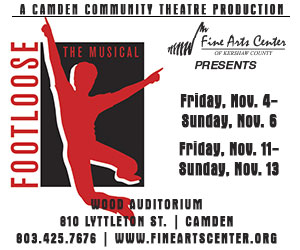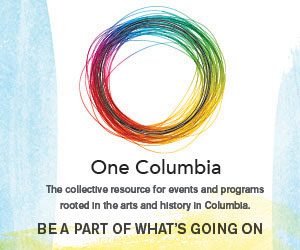The Lush World of Tish Lowe
By August Krickel
A stroll through the Italianate Arcade Mall is a trip back in time. Take the stairs to the second level on the Washington Street side, turn left, peek into the first studio space, and your journey to an earlier era is complete. Rich oil paintings of dusky Latin beauties adorn the walls, along with ballerinas frozen in mid-pose, intricately detailed nudes, lush still lifes, and rakish gentlemen in elegant garb. You almost expect to find a flamboyant Venetian from the Renaissance presiding over an artist’s salon, palette in one hand and perhaps a rapier in the other, a courtesan hidden away somewhere in the back. What you don’t expect is to be greeted by a petite, bespectacled lady, welcoming you with Southern graciousness and magnolia blossom charm.
Letitia “Tish” Lowe has made Columbia’s Arcade her studio home for a little over a year now. Classically trained artist is only the latest in a series of careers that range from playing organ and directing a 100-voice church choir to overseeing $5 billion in assets for World Bank, to touring rural Thailand on the back of a scooter driven by a guide nicknamed “Indiana Jones,” stopping along the way to ride elephants and brave river rapids on a bamboo raft.
Growing up in Jackson, Mississippi, Lowe’s goals were like those of many of her generation: to become a wife and mother. Both her father and grandfather took up painting as a hobby later in life, the former actually considering a career in art in his youth and serving as chairman of the local opera company and the symphony, so appreciation for culture was something learned early on. As a music major specializing in pipe organ at Agnes Scott College in Atlanta, Lowe also took a couple of classes in art and art history and spent a summer as an exchange student in Mexico, studying local art and language. “I considered being an artist,” she recalls, “but the career options at that time were graphic design and commercial art, which didn’t interest me.”
Post-graduation found Lowe married to a Presbyterian minister and serving as church organist and choirmaster, while maintaining a day job as a computer operator for IBM. Fast-forward a few years, and she was living in Knoxville and working in the computer department at the University of Tennessee. Seven years later, she had earned a doctorate in biological anthropology and was working for the Tennessee Valley Authority as both systems analyst and anthropologist. One door began to open onto another and then another in her career: an MBA at Yale, a move to Washington, DC, and a professional foray into international development and private-sector environmental work. As an executive with the International Finance Corporation (part of the World Bank Group) she ran a training program for international bankers on environmental risk management. Corporate downsizing brought about an early retirement and a compelling question from a career outplacement counselor: “What would you be doing if you didn’t have to work?” Her answer was instant and spontaneous: she would move to Italy and study art. A generous severance package allowed her opportunity to explore a dream.
“Every barrier I put up got knocked down,” and so in perhaps the best example of serendipity that one could imagine, Lowe spent the next six years in Florence, five as a student at the Angel Academy of Art. “I planned on a year,” she explains. “Once I got there and discovered what I could learn, I decided to stay for the four-year program, and then opted for another year focusing on portraits and composition. The sixth year I had planned as a year to enjoy traveling in Italy, since 12-14 hour days in the studio precluded much sightseeing. But I received some important portrait commissions and spent the year working instead. I still get inquiries from Italy from people wanting portraits.”
The Angel Academy’s method is seriously traditional and highly structured, the type used by 19th century French academies and by Renaissance painters. Focusing on the figure, “students must master specific techniques before moving to a higher level,” the thought being that if one can master the intricacies and details of the human figure, one can handle just about anything. “Students make pencil copies of academic drawings developed in the 1800s by Charles Bargue for the French academies; each day a half day is spent on pencil copies, and a half day is spent applying what one has learned to drawing of the figure from life in pencil. Second, when pencil has been mastered, students draw plaster casts and figures in charcoal. Third, after mastering charcoal, the student then begins to paint in oils from plaster casts. The plaster casts are white, so the student becomes familiar with oil painting techniques using a limited palette. Finally, color is added to a student’s repertoire through painting still lifes and the figure in oils. Students proceed at their own pace, and each student is different,” Lowe recalls “I spent two years on drawing before I was allowed to pick up a paint brush.”
Lowe’s final pencil drawing copy took 14 weeks to complete, and she drew and painted from live models daily for five years. People often ask her how long it takes for her to create a piece of art. “It depends on where you want to start,” she says, laughing. “First there’s five years of training to get to that point. Then there is buying the canvas, stretching it, priming it, waiting for it to dry. … Then there’s your composition, the sketching, then actually putting the paint onto the canvas.” If pressed, Lowe will point to a still life of pink roses in a jade-green vase, which took about five weeks from start to finish. For her work, she utilizes imported Belgian linen primed with gesso vero, the traditional type of canvas used by the old masters.
As much as Lowe loved Italy, she never planned to live there permanently. In 2009, wanting to ensure that her new career would be based in the United States for visa and tax purposes, she relocated to Columbia to be near family. Irene Simons (of the I. Pinckney Simons Gallery, now in Beaufort) was an early contact whom Lowe had met in previous visits to the area and was a great help in answering questions about galleries and the art business in general. After her first two years in Florence, Lowe returned to show Simons some of her work. Simons contacted a client, Charlton Hall, who was interested in Lowe’s style of work, and he became her first customer, purchasing her first nude and first still life works, thus helping to finance the rest of art school. Word of mouth remains a major source for Lowe’s referrals and commissions. A chance encounter with a frame shop owner in Florence led to two important portraits of heads of major Italian corporations, one a Knight of Labor (the equivalent of nobility, Lowe explains, in the post-aristocracy, socialist Italy of today). She feels that “drawing from the live model is critical to maintaining one’s skills.” Soon after her move, Lowe found the Columbia Museum of Art’s “About Face” program, which led in turn to a referral for a portrait of Dr. Charles P. Teague, President of Spartanburg Methodist College, who drove down to Columbia 10 times to sit for Lowe. In an ideal world, she prefers the chance to see a model for 20-30 hours, and painting from a photograph is her least favorite method.
“What makes a good photograph is not necessarily what makes a good painting,” she reflects. “A painting has to stand alone, beyond simply a likeness. It’s an impression of a person that you convey with paint.” She is quick to point out that however natural and lifelike her paintings may seem, she is nevertheless a classical realist, not a photo-realist. “A photograph captures a single instant, while painting from life is a composite of poses, with a different energy that both artist and model bring to the session each day. There’s a skill to capturing what transpires, and what then flows onto the canvas. Great art goes far beyond that and reflects a greater truth, beyond just the person and their experiences.” Clearly a topic she has put thought into, Lowe explains it further: “There is a point well into the portrait that everything falls away. We meet eye-to-eye, soul-to-soul; our souls connect, and then it flows out of me.”
Still life compositions are among Lowe’s most eye-catching work (her painting “Spanish Bowl” took an Award of Merit at the South Carolina State Fair in 2010, and “The Pram” was awarded the Chairman’s Choice Award at the International ARC Salon in 2007), but she remains especially fond of the human figure. “I have always thought that the human body, in all its many variations, is the most fascinating thing in the world.” With figures, she sees no ugly people. “Everyone is beautiful in their own way, although the outside may become a package that we judge people by,” she says. Lowe’s goal is simple: to express that beauty through her work. Among her many influences are Velasquez, Rembrandt, Caravaggio, and John Singer Sargent.
Lowe is aware that, once a painting is finished, in some way an artist has to let it go, because each person brings his or her own life experience when viewing a work of art. Her stark piece “The Pram,” for example, conjures an atmosphere of romance for some, often women, who note the vivid red roses, white candle, and hymnal in the foreground. Others, often male, tell her that they get a creepy, Tim Burton-esque vibe from a shadowy baby carriage. She points to a traditional rendering of a bottle of Chianti in a restaurant setting, which naturally suggests good food and good times. Yet if a viewer associates negative connotations with wine, perhaps due to some tragedy suffered, the exact same image can be one of sadness.
Since relocating to Columbia, Lowe has made a big splash in a small amount of time, participating in an About Face exhibition in conjunction with the opening gala for the Turner to Cezanne exhibition at the Columbia Museum of Art and in an About Face show at 300 Senate, followed by a solo show there. Jan Swanson got Lowe’s name from the waiting list for Vista Studios when she and other artists were contemplating a move to the Arcade. When Lowe walked into the building, she felt right at home, as if she were back in Italy. She participated in the October 2010 First Thursday event, and visitors quickly told their friends further up Main Street, “You have GOT to come see this artist!” Faith Mathis, currently studying art at Columbia College, was one who was dragged by friends into the Arcade to see Lowe’s work. “Her paintings hold an Old World elegance long abandoned by today’s digital media artists,” Mathis says. “Her art holds true to the fact that the human touch will always be greater prized, and much more appreciated, because of the years of skill and discipline it takes to learn master artistry.” Faith’s mother, watercolorist Barbie Mathis, sums it up more simply: “The Columbia Museum of Art needs to build an extra room to hold the works of Tish Lowe, because she is a true master.”
Lowe also recently participated in the annual Unearth event at Saluda Shoals Park, recreating a challenge from her undergraduate years, in which she drew using natural objects instead of pen or pencil, i.e. sticks, rocks, leaves, berries, and other natural objects she picked up along the trails. “It was an exercise in both perspective and variety of lines,” she says. Having worked in the environmental field, “it was great to be back in nature, combining two of my passions, art and environment.” Music remains another passion. Lowe serves on the board of The Palmetto Opera; its goal is “to have a full season of grand opera in Columbia within five years.” The organization’s next project is partnering with the acclaimed Teatro Lirico D’Europa, an international touring company with more than 4,000 performances worldwide, to bring Verdi’s La Traviata to the Koger Center on March 3, 2012. Lowe points out that “Teatro’s production of La Traviata sold out this fall in Paris and other venues in France, Italy, and Spain, and in Baltimore last spring, so we are very excited about the upcoming production.”
As a relative newcomer, Lowe has found Columbia’s arts community “to be diverse and unexpectedly vibrant.” She notes that it was “not until I moved my studio from the suburbs into the Arcade Mall downtown that I became aware of all the opportunities available in this city. A wide range of visual artists, ballerinas, poets, folk and rock musicians, actors, photographers, and art aficionados have passed through my studio doors and shared their enthusiasm with me. The arts community needs to reach out into the suburbs better with information and marketing about what’s happening.”
With her background in business and her experiences in Italy, Lowe realizes that “one of the reasons the arts flourished in Florence during the Renaissance was that, being good capitalists, the city’s leaders used competition to raise the standard of excellence. They also were aware of what was happening in the arts outside their city. We can learn from their example. Columbia is fortunate to have a mayor who is supportive of the arts and recognizes their contribution to the city’s welfare.” She makes a good cheerleader for the importance of the arts in commerce: “To attract high-quality corporations, businesses, and professionals, cities and states need a strong cultural milieu that includes opera as well as symphony, art museum, ballet, and theater.”
Along those lines, Lowe also hopes to accomplish some goals for the greater good via her artwork. She recalls that artists of previous centuries began to paint more and more from life, reflecting poverty and the hardships enduring by the working classes and the poor in their work; wealthy patrons purchased these works for their inherent beauty and craftsmanship, but gradually had their eyes opened to bigger issues in society that they might not have seen in person. Lowe wants to focus more on “important issues of the spirit” in her work, everything from the compassion and caring shown by the staff in a nursing home setting, for example, to darker issues that confront society, like the exploitation of children. Her hope is that “the beauty of a painting will attract viewers’ attention and, in so doing, force them to see what they would normally ignore and compel them to take action.”
Her loftier and long-range goals notwithstanding, Tish Lowe continues to be a working portrait artist, available for commissions. Just take a turn off Main into the Arcade, hang a right at the first cherub, head upstairs, and prepare to enter Lowe’s lush world of classical realism. For more information, visit www.tishlowe.com.






.jpg)
